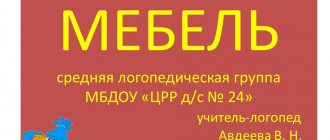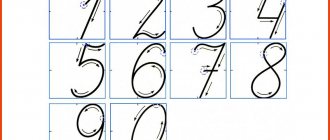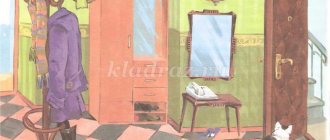Counting material for teaching children
In order for a child to successfully comprehend the basics of mathematics, adults often have to use various visual aids. Among them, a special place is given to counting material. When choosing it from a huge variety, you need to choose the option that will be convenient for you and interesting for children.
In mathematics classes, objects are elements of sets with which certain actions must be performed. Regarding them, a specific question about their quantity can be raised. Some points that may be of interest in classes in another subject are not specified here. For example, if we are talking about birds on a branch, then it does not matter what kind of birds they are.
In mathematics, attention is paid only to quantity and quantitative relationships. In order for children to understand the material, counting material is often used.
This type of visual aids includes counting sticks, abacus, counting boards, or, as they are called differently, abaci, an arithmetic box, geometric mosaics, various sets of thematic or geometric figures for counting, and cash registers of counting materials.
Choosing the right means for teaching children will make learning fun and exciting. The importance of this is due to the fact that children, right up to the start of primary school, learn and remember new things much more effectively if they are interested.
Among the factors that determine your choice should be the materials from which the sets are made, the appropriate age of the children, and the preferred shapes.
A variety of materials are used to make counting material sets. These can be cardboard cards, high-strength plastic or wooden figures, or magnetic elements. When making a choice in favor of a particular material from which the counting material is made, you should first of all take into account its safety and environmental friendliness.
Thus, aids made of wood are considered environmentally friendly and pleasant to the touch. They are typically hand painted with safe, non-toxic paints. High-quality plastic figurines can last longer and are lighter in weight than wooden ones. You should choose only high-quality, high-strength plastic that has no foreign odors. It’s easy to make the necessary materials yourself from cardboard, and you can even involve your child in this process. Magnetic cards are convenient for teachers to use on the board to demonstrate to a large number of children. They are also suitable for those who have a small magnetic board at home.
We offer an overview of the most popular and popular sets for teaching counting to young children.
It is very convenient to store the kit at home or in the classroom in the plastic pencil case included in the kit. The counting material itself is wooden, which makes it absolutely safe. The kit includes:
- counting sticks (20 pcs);
- squares – green, red and blue colors;
- circles of red, yellow, green colors;
- squares (two types and colors);
- plates: numbers and signs (28 pcs).
This set can be used in classes with children 5-10 years old at home, in kindergarten and school. With its help, the baby will be able to get acquainted with the basics of geometry, numbers, and learn to perform simple counting operations. The child will be able to put together fancy pictures from geometric shapes, developing imagination and fine motor skills. He will also be able to learn to find patterns and continue the sequence, which will contribute to the development of logical thinking, teach him to compare, reason, classify and draw conclusions.
A good set that can be used from the age of five. The set includes 132 elements made of high-quality plastic - geometric shapes, counting sticks and numbers, which are packed in a convenient plastic case.
With its help, you can introduce your baby to numbers and geometric shapes. Children will be able to form numbers and learn to solve examples and problems.
The kit is designed to work on a magnetic board in the following sections:
- an account with a change in the basis of the account and according to the conceptual measure;
- development of the ability to classify;
- the ability to divide a whole into equal parts;
- relationship between the whole and the part;
- sets, union of sets;
- problem solving;
- composition of numbers.
The set includes geometric shapes made from laminated cardboard - red, yellow, green and blue. The magnets must be attached to them yourself.
Set contents:
- circle division (diameter 20 cm) – 1, 1/2, 1/3, 1/4, 1/5, 1/6, 1/8, 1/9, 1/12.
- A square with a side of 12 cm and dividing it into parts in two ways: 1, 1/2, 1/4, 1/5, 1/8, 1/9.
- Circle, diameter 8 cm – 12 pcs. one color, 6 pcs. – other, 1 piece – 1/2+1/2.
- Counting sticks up to 10 in length in increments of 2.5 cm and up to 7 in width in increments of 1.5 cm.
- Geometric shapes: square, equilateral triangle, circle in two colors, 10 pieces each.
- Numbers and signs.
- Additional geometric shapes: rhombus (1 piece), trapezoid (2 pieces), equilateral (3 cm, 1 piece), obtuse (1 piece) and rectangular (1 large and 2 small) triangles, circle with a diameter of 3 cm (10 pieces) .
The set includes such geometric shapes as square, circle, rectangle, hexagon - 10 pcs each, triangles with angles of 30° and 45° - 20 pcs each. There is also a set of numbers from 0 to 9 - 2 pcs each, signs and counting sticks - 20 pcs.
To work with counting material in kindergarten, you should choose bright and colorful aids. With the help of an interesting design, it is much easier to attract the attention of preschoolers and make learning a fun, interesting game. It needs to be changed periodically so that the children are constantly engaged in the learning process. Today you can work with hedgehogs; in the next lesson, count how many birds have arrived.
For younger children, choose beautiful bright figures and sets with which you can teach your child to count to 20. Older preschoolers are already eager to go to school as soon as possible. At this age, children may like sets in a beautiful pencil case, because it is a necessary attribute of school education.
Children 6-7 years old and elementary school students who have already become acquainted with the basics of counting in the preparatory groups of kindergarten can be offered various sticks, cash registers, and abacus. Using them, you are no longer attached to gaming activities. The manuals help the child visually and make it easier to understand the mathematical operations that need to be done. With their help, it is easier for a primary school student to navigate the connections between the abstract and the concrete.
For children under 5 years old, counting material in the form of various figures is suitable. These could be apples, mushrooms, nesting dolls, various vegetables, transport, animals. With the help of such forms, you can play out many different situations to teach your child to count. Today the hedgehog will bring mushrooms, and the squirrel will bring apples. Tomorrow you will count how many vegetables you will add to the soup. Later, distribute the carrots to the bunnies. The most important thing at this age is play, which should not be forgotten by an adult working with a child.
It is also necessary to use three-dimensional numbers so that the baby correlates the concept of number and numbers. He will remember each number much better if he can touch it, run his finger along each line. After all, tactile perception plays a huge role in the development of a baby from a very young age.
Children of senior preschool age and primary school students can already be offered various geometric shapes as counting material, which can also be used as mosaics. This way, the child will be able to remember the name of the shapes, learn the main colors, and will lay out various pictures from the details.
Also, children of this age may like sets with 1 cm cubes. Such sets can be used not only for counting. With their help, the child will learn to sort, construct graphic images, and become familiar with the concepts of “perimeter,” “volume,” and “area.”
Counting sticks are a universal educational tool for children of all ages. The youngest will need strict adult supervision. With their help, you can begin to develop a child as early as 9 months. They will help develop fine motor skills, learn colors, many different concepts, such as “one-many”, “wide-narrow”, “long-short”, etc.
They help teach a child to compare, find similarities and differences, promote sensory development, develop logic, imagination, and the ability to think outside the box. With the help of sticks, the child will be able to get acquainted with the basics of geometry. And, of course, they will help in teaching your child to count and become familiar with basic mathematical operations.
Any parent can make counting material with their own hands, which will significantly save the family budget. You can make it from improvised materials that are at home:
- Numbers
- Counting from 1 to 10
- Number composition
- Subject pictures
- Geometric figures
- Math puzzles
You can also use beads, clothespins, fabric appliqués, and various waste materials.
There are a lot of different options, all an adult has to do is turn on their imagination and express themselves. You can cut and glue from cardboard, you can sew and knit, you can draw - do what you like. For a child, aids that are made with love by his mother will be the most beloved.
In order to teach a child to calculate, you can use a wide variety of counting materials: abacus, abacus, sticks, cards, various ready-made sets of counting materials, etc. In primary school lessons, teachers also use all these aids to teach children various counting operations.
Advantages of using counting materials:
- visual demonstration of the computational actions performed;
- accessibility of understanding the meaning of arithmetic operations;
- the use of counting materials helps in the development of fine motor skills;
- accessibility - you can always find counting material at hand without purchasing anything special.
Disadvantages of using counting materials:
- the habit of using any objects for counting sometimes complicates the child’s transition from an objective environment to an abstract mental form;
- There is a wide choice of different counting materials. For adults who are not specialists, it is sometimes difficult to understand the teaching methods of a particular manual.
The abacus is somewhat reminiscent of the Soviet abacus. It is a wooden frame with knitting needles, on which 5 dominoes are strung. The number of knitting needles may vary. The knitting needles pass through a bar that separates the knuckles. There is one domino above the knitting needle, and four below it.
When counting on the abacus, the ability to work with the thumb and forefinger is very important. With the help of repeated repetitions it is necessary to bring it to automaticity. Keep in mind that this skill is quickly forgotten without regular training.
Arrangement of number lines: Each digit occupies its own spoke. The domino below the dividing bar indicates 1, above the dividing bar - 5. Let's look at a specific example. The number 3 on the abacus will be marked like this:
Here, one domino is raised on the tens digit, and on the units we lower the domino, which represents 5.
Thus, numbers are deposited on the abacus and various counting operations are performed. With it you can add, subtract, multiply, divide and even raise to a power. However, such complex operations are already the basics of mental arithmetic, to get acquainted with which it is better to attend a course of relevant classes.
Counting material is necessary when teaching children mathematics at home, in kindergarten and school. It is presented in a wide variety in stores. But it is not always convenient to use purchased items. Among your things you can find something that your baby will like best. Learn the basics of mathematics with your little one with pleasure and always by playing, then the learning process will be much easier.
For information on what counting material is, see the following video.
o-krohe.ru
Slide captions:
“Sound line” Master class for parents
Step 1. Take 2 sheets of paper or cardboard.
Step 2. On the first sheet, mark 3 equal stripes horizontally.
Step 3. Draw and cut out circles on the stripe that is in the middle. For example 5. Fold the edges along the line so that one covers the other and glue it to secure our ruler.
Step 4. On the second sheet, also mark 3 equal stripes and cut. 1 for closing sounds 2 for sounds 2 for sounds
Step 5. Take colored paper (blue, green, red) - Hard consonants - Soft consonants - Vowels
Step 6. Cut colored paper into equal rectangles or squares. The main thing is that they fit into the cut out circles on the sound ruler!
Step 7. We come up with a word with from 2 to 6 sounds.
Step 8. Take a strip, insert it into our sound ruler and draw circles.
Step 9. Glue our word onto the strip with circles. Let's look at the word "peace". It's the same strip!
Step 10. “Reading” the word on the sound line: we pronounce the sounds while simultaneously opening the windows with them. The 1st sound [m `] - sounds soft, as it comes before the sound [ and ]. (green rectangle) The 2nd sound [ and ] is a vowel. We can sing it. (red rectangle) 3rd sound [p] - consonant. This is a solid sound. (blue rectangle)
Master class on making a sound ruler
Tatyana Getmanskaya
Master class on making a sound ruler
The main task in the process of teaching literacy is to form in preschoolers a general orientation in the sound system of the language , teaching them the sound analysis of a word (determining the order of sounds in a word , establishing the distinctive role sound , its main qualitative characteristics). Children cannot master sound analysis sound lines in my work , which help to perceive information visually. The lines are like this :
this ruler has pockets in which, for phonetic ( sound-letter )
while parsing the word, children insert colored rectangles





